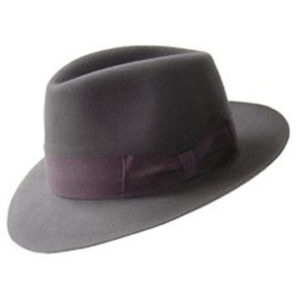 School Clothes, Play Clothes, and Sunday Best:
School Clothes, Play Clothes, and Sunday Best:
The Fedora Story
School bells ring and children sing
it’s back to Robert Hall again
Mother knows for better clothes
It’s back to Robert Hall again
You’ll save more on clothes for school.
Shop at Robert Hall!
1963: The boy hated that commercial. In fact he hated all of those late-summer “back-to-school” ads that ran on TV and in the papers; they only served to remind him of his inevitable doom. But of all those commercial messages, the Robert Hall jingle was the worst.
Each summer he looked forward to his birthday, which fell during the last week of August; but once that special day was over, it seemed like there was nothing left to live for. The next week, on that first day of school, the bus would arrive routinely, swallow him up, and transport him from the sunny land of fun and freedom to the dark and gloomy land of rules and conformity.
It was always hard for him to sleep on that last night before his incarceration. The boy knew full well that his only means of escape during those long days in class would come from his over-developed ability to daydream.
In 1963, his clothing fit into three categories: school clothes, play clothes and “Sunday best.” At that time, hand-me-downs were the norm in most families, and the boy’s daily wear would eventually be inherited by his younger brother; however when it came to Sunday clothing, families went all-out. T
he year the boy turned 11, his mother decided that it was time for him have a suit for Sunday best—furthermore, it was time for him to take dancing lessons at the Williams Ballroom Studio—for mother was determined that the boy would become a Young Gentleman.
On the other hand, the boy was equally determined that he would remain Just a Boy. This time, mother won both battles, and before long the boy was standing in front of a full-length mirror, wearing a suit and a skinny necktie, and eyeing himself with disgust. Years later, he would recognize something of his youth when he watched Dan Akroyd dance across the screen in “The Blues Brothers.”
To cheer him up, mother declared with great gusto, “Today you are a man!” But the boy hardly heard her, for he was thinking with dread about dancing. The lessons would be starting soon, and he would learn to dance the waltz and the foxtrot and the bop—like it or not. And, he supposed, this meant he would have to dance with girls; could it get any worse than that?
It could. To add to the boy’s humiliation, it had been decided that when going to church, a young gentleman must wear a fedora hat on his head; this only served to traumatize him further.
On the second Sunday that he wore the suit and hat to church, after worship his parents decided to go lollygagging around the church’s coffee hour with their friends. The boy had no interest in that, so he went outside to look for adventure.
On this day, he pretended he was practicing for the Olympics, as he ran around outside, jumping from one thing to another. On the second or third jump, he slipped (there is a reason why they don’t wear leather shoes in the Olympics, you know), and skinned his knee. And of course the only way to skin his knee, was to first grind a hole through his new suit pants!
So, after coffee time was over, the boy and his family all rode home from church in the 1957 Ford station wagon. Now, for the first time, he was happy to have that fedora, because it was hiding the offending knee from everyone’s sight (his sister would tell on him for sure, so she couldn’t be allowed to know). Nobody knew the awful secret until they got home—and then the feathers hit the fan!
A few days later, mother mended the knee of the suit pants, and the boy wore that patched suit until he had outgrown it–which didn’t take long since he grew six inches that year. For some odd reason, his parents didn’t bother him much about suits after that: 1963 turned into 1964, styles began to change, and eventually the whole idea of wearing a hat to church went away as well, much to the boy’s relief.
Since then, the years and the decades have passed; and although the memory of that day has mostly faded like many a long forgotten nightmare, it did leave its mark: the boy went on into adulthood with a lifelong aversion to hats and suits, and unlike Dan Akroyd, he never did learn how to dance.